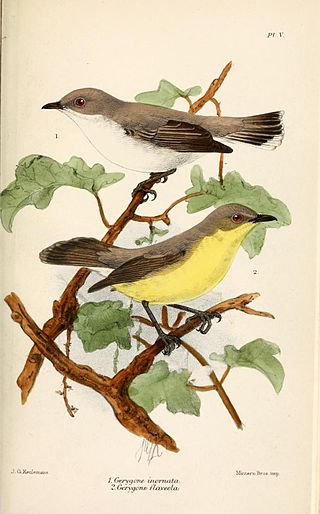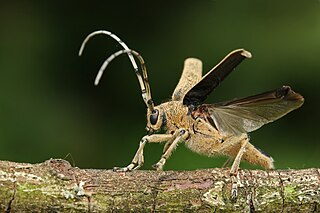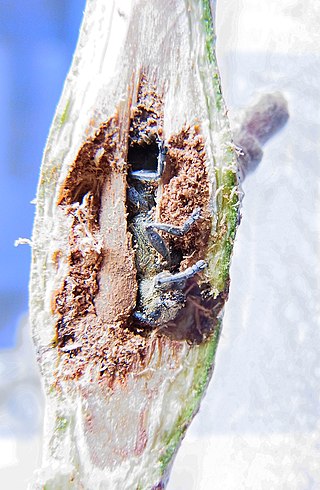
Salvadori's pheasant is a landfowl bird of genus Lophura, native to Indonesia. It is found in the mountain rainforests of Sumatra. Thus it is also known as the Sumatran pheasant. The Hoogerwerf's pheasant is usually thought to be a subspecies. This bird was first described in 1879 by the Italian ornithologist Tommaso Salvadori. The species name inornata means "without ornament".
The Mauke starling or mysterious starling is an extinct species of starling found on the island of Mauke, Cook Islands. The binomen is the result of Buller's misreading of the name inornata on the specimen label. As he seems to have genuinely believed this spelling to be correct, the binomial, although it has no meaning, is valid.

The unadorned rock-wallaby is a member of a group of closely related rock-wallabies found in northeastern Queensland, Australia. It is paler than most of its relatives and even plainer, hence its common name.

The plain gerygone is a species of bird in the family Acanthizidae. It is found on the islands of Wetar and Timor. Its natural habitats are subtropical or tropical moist lowland forest and subtropical or tropical mangrove forest.

Thereva is a genus of flies from the family Therevidae commonly known as stiletto flies.

Saperda carcharias is a species of longhorn beetle.

Saperda is a genus of flat-faced longhorn beetles belonging to the family Cerambycidae, subfamily Lamiinae. The genus was erected by Johan Christian Fabricius in 1775.

Forsterinaria is a genus of satyrid butterflies found in the Neotropical realm.

Saperdini is a tribe of longhorn beetles of the subfamily Lamiinae.

Dorcaschema alternatum is a species of beetle in the family Cerambycidae. It was described by Thomas Say in 1824, originally under the genus Saperda. It is known from the United States. It feeds on Morus celtidifolia.

Saperda calcarata, the poplar borer, is a species of beetle in the family Cerambycidae. It was described by Thomas Say in 1824. It is known from Canada and the United States. It contains the varietas Saperda calcarata var. adspersa.
Saperda mutica is a species of beetle in the family Cerambycidae. It was described by Thomas Say in 1824. It is known from Canada and the United States.

Saperda puncticollis is a species of beetle in the family Cerambycidae. It was described by Thomas Say in 1824. It has been found in Canada and the United States.

The Linden borer is a species of beetle in the family Cerambycidae. It was described by Thomas Say in 1824. It is known from Canada and the United States. It feeds on Tilia americana.
Saperda obliqua is a species of beetle in the family Cerambycidae. It was described by Thomas Say in 1826. It is known from Canada and the United States.

Saperda candida, the roundheaded appletree borer, is a species of beetle in the family Cerambycidae. It was described by Johan Christian Fabricius in 1787. It is known from Canada and the United States. It contains the varietas Saperda candida var. bipunctata.
Saperda interrupta is a species of beetle in the family Cerambycidae. It was described by Gebler in 1825. It is known from China, Russia, Siberia, Korea and Japan. It is associated with coniferous plantations, and infests species of fir, pine, spruce and other conifers.
Saperda lateralis is a species of beetle in the family Cerambycidae. It was described by Johan Christian Fabricius in 1775. It is known from Canada and the United States.

Saperda perforata is a species of beetle in the family Cerambycidae. It was described by Pallas in 1773, originally under the genus Cerambyx. It has a wide distribution in Europe. It feeds on Populus nigra, Populus alba, and Populus tremula. It is preyed upon by the parasitoid wasp Xorides indicatorius.

Saperda populnea, the small poplar borer, is a species of beetle in the family Cerambycidae which forms woody galls on twigs of poplars and willows. It was described by Carl Linnaeus in 1758.














